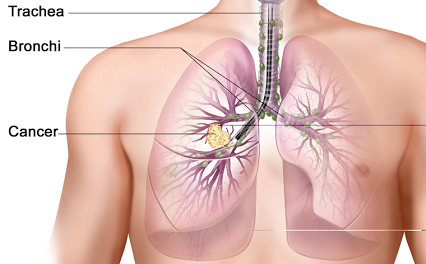The immoderate growth of abnormal cells that begin to build in one or both lungs; generally in the cells that line the air passages known as Lung Cancer. The abnormal cells do not develop into healthy lung tissue, they divide rapidly and form tumors.
 As tumors become larger and more numerous, they undermine the lung’s ability to provide the bloodstream with oxygen. Tumors that remain in one place and do not appear to spread also known as “Benign Tumors.”
As tumors become larger and more numerous, they undermine the lung’s ability to provide the bloodstream with oxygen. Tumors that remain in one place and do not appear to spread also known as “Benign Tumors.”
Malignant Tumors, the more hazardous tumors that further spread to various parts of the body either through the lymphatic system or the bloodstream. Metastasis refers to cancer spreading beyond its site of origin to other parts of the body. When cancer spreads, it is much harder to treat successfully.
Primary Lung Cancer originates in the lungs, while secondary Lung Cancer starts somewhere else in the body, metastasis, and reaches the lungs. Both of them have a difference in their types and thus treated in different ways.
Types of Lung Cancer
Non-Small Cell
Non-small cell lung cancer (NSCLC) comes from epithelial cells and is the most common type.
Small-Cell
Small cell lung cancer start building in the hormone-producing cells of the lung or the nerve cells. The term “small cell” refers to the size and shape of the cancer cells as seen under a microscope. It is essential for doctors to differentiate small cell lung cancer from NSCLC because these two cancers are usually treated in different ways.
Symptoms
 A new cough that does not go away
A new cough that does not go away- Changes in a chronic cough or “smoker’s cough.”
- Coughing up blood, even a small amount
- Shortness of breath
- Chest pain
- Wheezing
- Hoarseness
- Losing weight without trying
- Bone pain
- Headache
- Swelling of the neck and face
- Loss of appetite
- Fatigue
Treatments
Lobotomy
The lungs have five lobes, three in the right lung and two in the left lung. A lobectomy (removal of an entire lobe of the lung) proves to be the most effective type of surgery, for NSCLC, even when the lung tumor is very small.
A Wedge
If the surgeon cannot remove an entire lobe of the lung, the surgeon can remove the tumor, surrounded by a margin of normal lung.
Pneumonectomy
The surgeon needs to remove the whole lung if the tumor is near to the center of the chest.
Radiofrequency Ablation
Radiofrequency ablation (RFA) inserted into the tumor through a needle to destroy cancer with an electrical current. Constantly used for a lung tumor that cannot be destroyed with the various types of surgery mentioned above. The time it takes to recover from lung surgery depends on how much of the lung is removed and the health of the patient before surgery. Speak with your medical management team about what to expect before surgery, covering possible side effects and recovery time.
Adjuvant Therapy
Adjuvant therapy treatment is given after surgery to lower the risk of the lung cancer returning. It also includes radiation therapy, chemotherapy, and possibly targeted therapy. This therapy is intended to get rid of any lung cancer cells that may still be in the body after surgery. It may decrease the risk of recurrence, though there is always some risk that cancer will come back.
Radiation Therapy
Radiation therapy is the use of high-energy X-rays or other particles to kill cancer cells. The most common type of radiation treatment also known as external-beam radiation therapy, in which radiation is given from a machine outside the body. Radiation treatment when given using implants, called Brachy Therapy or internal radiation therapy. A radiation therapy procedure mainly involves a particular number of treatments given over a set period.
Chemotherapy
The usage of drugs to destroy cancer cells, generally by stopping the cancer cells’ strength to divide and grow is known as Chemotherapy. Systemic chemotherapy distributed via the bloodstream to reach cancer cells throughout the body. Most chemotherapy used for lung cancer directly injected into a vein (called intravenous, or IV injection). A chemotherapy procedure basically includes a certain number of cycles given over a set period. A patient may receive one drug at a time or combinations of different drugs at the same time.
Targeted Therapy
Targeted therapy is a treatment that targets cancer’s specific genes, proteins, or the tissue environment that contributes to cancer growth and survival. This type of treatment blocks the growth and spread of cancer cells while limiting damage to normal cells. To discover the most successful treatment, your doctor may go through various tests to identify the proteins, genes, and some other factors in your tumor. For some lung cancers, abnormal proteins generally found in large amounts in the cancer cells. Also, many research studies are taking place now to find out more about specific molecular targets and new treatments directed at them.





